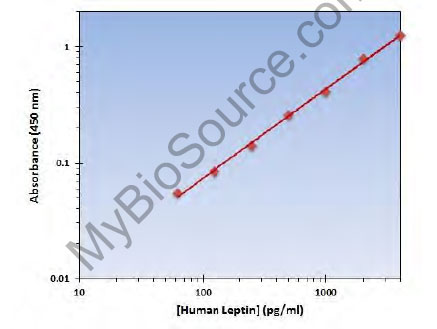Human Monocyte Chemotactic Protein 1 ELISA Kit | MCP-1 elisa kit
Human Monocyte Chemotactic Protein 1 ELISA Kit
Reactivity
Human
Synonyms
Monocyte Chemotactic Protein 1; N/A; Human Monocyte Chemotactic Protein 1 ELISA Kit; MCP-1/CCL2/GDCF-2/HC11/HSMCR30/MCAF/MCP1/SCYA2/SMC-CF; MCP-1 elisa kit
Reactivity
Human
Specificity
Specifically recognize MCP-1, no obvious cross reaction with other analogues
Sequence Length
44
Assay Type
Sandwich
Samples
Serum, plasma, cell culture supernatant and other biological samples
Detection Range
15.625-1000pg/ml
Sensitivity
9.375pg/ml
Intra-assay Precision
Intra-assay Precision: samples with low, medium and high concentration are tested 20 times on same plate.
Inter-assay Precision
Inter-assay Precision: samples with low, medium and high concentration are tested 20 times on three different plates.
Preparation and Storage
Store entire kit at 2-8C for short-term. For longer-term, please store the microplate & standard at -20C, while the remaining reagents can be stored at 2-8C
Related Product Information for MCP-1 elisa kit
Background: MCP-1, also known as Monocyte Chemoattractant Protein-1, can cause the chemotaxis and activation of monocytes. It is produced by various cells, including monocytes, endothelial cells, smooth muscle cells, and fibroblasts. MCP-1 plays an important role in inflammation and immune responses. After tissue damage or infection, MCP-1 is produced and released into surrounding tissues, attracting immune cells such as monocytes and macrophages to the site of injury and participating in the inflammatory response and healing process. In addition, MCP-1 is involved in the development and progression of various diseases such as cardiovascular disease, cancer, and diabetes.
Principle of the Assay: This kit was based on sandwich enzyme-linked immune-sorbent assay technology. Anti MCP-1 antibody was pre-coated onto the 96-well plate. The biotin conjugated anti MCP-1 antibody was used as the detection antibody. The standards and pilot samples were added to the wells subsequently. After incubation, unbound conjugates were removed by wash buffer. Then, biotinylated detection antibody was added to bind with MCP-1 conjugated on coated antibody. After washing off unbound conjugates, HRP-Streptavidin was added. After a third washing, TMB substrates were added to visualize HRP enzymatic reaction. TMB was catalyzed by HRP to produce a blue color product that turned yellow after adding a stop solution. Read the O.D. absorbance at 450nm in a microplate reader. The concentration of MCP-1 in the sample was calculated by drawing a standard curve. The concentration of the target substance is proportional to the OD450 value.
Principle of the Assay: This kit was based on sandwich enzyme-linked immune-sorbent assay technology. Anti MCP-1 antibody was pre-coated onto the 96-well plate. The biotin conjugated anti MCP-1 antibody was used as the detection antibody. The standards and pilot samples were added to the wells subsequently. After incubation, unbound conjugates were removed by wash buffer. Then, biotinylated detection antibody was added to bind with MCP-1 conjugated on coated antibody. After washing off unbound conjugates, HRP-Streptavidin was added. After a third washing, TMB substrates were added to visualize HRP enzymatic reaction. TMB was catalyzed by HRP to produce a blue color product that turned yellow after adding a stop solution. Read the O.D. absorbance at 450nm in a microplate reader. The concentration of MCP-1 in the sample was calculated by drawing a standard curve. The concentration of the target substance is proportional to the OD450 value.
NCBI and Uniprot Product Information
NCBI GI #
Molecular Weight
5,028 Da
NCBI Official Full Name
monocyte chemotactic protein-1, partial
UniProt Protein Name
Monocyte chemotactic protein-1
UniProt Gene Name
MCP-1
UniProt Entry Name
A0A075IJR0_MUSPF




















